Influencing Mechanism of Potential Factors on Passengers’ Long-Distance Travel Mode Choices Based on Structural Equation Modeling
Abstract
:1. Introduction
2. Literature Review
2.1. Travel Behavior Investigation Literature Review
2.2. Structural Equation Modeling
3. Methods
3.1. Survey
3.2. Data and Independent Variables
4. Descriptive Analyses
4.1. Effects of Passengers’ Socio-Demographic Characteristics on Mode Choice
4.2. Effect of Service Preference Attributes on Mode Choice
4.3. Effect of Performance Satisfaction Attributes on Mode Choice
4.4. Effect of Travel Distance on Mode Choice
4.5. Summarization on Travel Modes’ Competitiveness and Relevant Suggestions
5. SEM Development and Results
5.1. Variables System and Models
5.2. Verification of Hypotheses: Structural Model of Passengers’ Travel Mode Choice
5.3. Fit Indices of SEM Model
6. Conclusions
Acknowledgments
Author Contributions
Conflicts of Interest
References
- National Bureau of Statistics of China. Available online: http://www.stats.gov.cn/ (accessed on 19 October 2017).
- Liu, J.; Zhang, N. Empirical Research of Intercity High-speed Rail Passengers’ Travel Behavior Based on Fuzzy Clustering Model. J. Transp. Syst. Eng. Inf. Technol. 2012, 12, 100–105. [Google Scholar] [CrossRef]
- Fu, X.; Zhang, A.; Lei, Z. Will China’s airline industry survive the entry of high-speed rail? Res. Transp. Econ. 2012, 35, 13–25. [Google Scholar] [CrossRef]
- Nostrand, C.V.; Sivaraman, V.; Pinjari, A.R. Analysis of long-distance vacation travel demand in the United States: A multiple discrete–continuous choice framework. Transportation 2013, 40, 151–171. [Google Scholar] [CrossRef]
- Lu, Y.J.; Zhang, L. Imputing Trip Purposes for Long-Distance Travel. Transportation 2015, 42, 581–595. [Google Scholar] [CrossRef]
- Reichert, A.; Rau, C.H. Mode use in long-distance travel. J. Transp. Land Use 2015, 8, 87–105. [Google Scholar] [CrossRef]
- Dargay, J.M.; Clark, S. The determinants of long distance travel in Great Britain. Transp. Res. Part A 2012, 46, 576–587. [Google Scholar] [CrossRef]
- Arbués, P.; Baños, J.F.; Mayor, M.; Suárez, P. Determinants of ground transport modal choice in long-distance trips in Spain. Transp. Res. Part A 2016, 84, 131–143. [Google Scholar] [CrossRef]
- Sung, H.G. Determinants of Transportation Mode Choice for Long-distance Travel in Korea - Focused on High-speed Rail over Private Car. J. Korea Plan. Assoc. 2014, 49, 245–257. [Google Scholar] [CrossRef]
- Lu, Q.C.; Zhang, J.; Peng, Z.R.; Rahman, A.B.M.S. Inter-City Travel Behaviour Adaptation to Extreme Weather Events. J. Transp. Geogr. 2014, 41, 148–153. [Google Scholar] [CrossRef]
- Kim, S.; Ulfarsson, G.F. Travel mode choice of the elderly: Effects of personal, household, neighborhood, and trip characteristics. Natl. Res. Counc. 2004. [Google Scholar] [CrossRef]
- Georggi, N.L.; Pendyala, R.M. Analysis of Long-Distance Travel Behavior of the Elderly and Low Income. Transp. Res. Circ. 2012, E-C026, 121–150. [Google Scholar]
- Mallett, W.J. Long-distance travel by low-Income households. TRB Transp. Res. Circ. 2001, E-C026, 169–177. [Google Scholar]
- Santos, G.; Maoh, H.; Potoglou, D.; von Brunn, T. Factors influencing modal split of commuting journeys in medium-size European cities. J. Transp. Geogr. 2013, 30, 127–137. [Google Scholar] [CrossRef]
- Mabit, S.L.; Rich, J.; Burge, P.; Potoglou, D. Valuation of travel time for international long-distance travel results from the Fehmarn Belt stated choice experiment. J. Transp. Geogr. 2013, 33, 153–161. [Google Scholar] [CrossRef]
- Wang, S.; Zhao, P. Analysis of passengers’ choice behavior for dedicated passenger railway lines based on Logit model. J. China Railw. Soc. 2009, 31, 6–10. [Google Scholar]
- Abdel-Aty, M.; Jovanis, P. A Survey of the Elderly: An Assessment of Their Travel Characteristics. In Proceedings of the 77th Annual Meeting of the Transportation Research Board, Washington, DC, USA, 11–15 January 1998. [Google Scholar]
- Redman, L.; Friman, M.; Gärling, T.; Hartig, T. Quality attributes of public transport that attract car users: A research review. Transp. Policy 2013, 25, 119–127. [Google Scholar] [CrossRef]
- Yu, C.C. Factors affecting airport access mode choice for elderly air passengers. Transp. Res. Part E 2013, 57, 105–112. [Google Scholar]
- Paulley, N.; Balcombe, R.; Mackett, R.; Titheridge, H.; Preston, J.; Wardman, M.; Shires, J.; White, P. The demand for public transport: The effects of fares, quality of service, income and car ownership. Transp. Policy 2006, 13, 295–306. [Google Scholar] [CrossRef]
- Janic, M. A model of competition between high speed rail and air transport. Transp. Plan. Technol. 1993, 17, 1–23. [Google Scholar]
- Rothengatter, W. Competition between airlines and high-speed rail. In Critical Issues in Air Transport Economics and Business; Macario, R., van de Voorde, E., Eds.; Routeledge: Oxford, UK, 2011. [Google Scholar]
- Gonzalez-Savignat, M. Competition in air transport: The case of the high speed train. J. Transp. Econ. Policy 2004, 38, 77–108. [Google Scholar]
- Parkan, C. Measuring the operational performance of a public transit company. Int. J. Oper. Prod. Manag. 2002, 22, 693–720. [Google Scholar] [CrossRef]
- Su, F.; Bell, M.G.H. Transport for older people: Characteristics and solutions. Transp. Econ. 2009, 25, 46–55. [Google Scholar] [CrossRef]
- Yin, H.; Guan, H.; Liu, T.; Gong, L. Study of urban resident travel mode choice behavior. In Proceedings of the 10th International Conference of Chinese Transportation Professionals—Integrated Transportation Systems: Green, Intelligent, Reliable, ICCTP 2010, Beijing, China, 4–8 August 2010. [Google Scholar]
- Wu, J.; Yang, M. Modeling Commuters’ Travel Behavior by Bayesian Networks. Procedia Soc. Behav. Sci. 2013, 96, 512–521. [Google Scholar] [CrossRef]
- Golob, T.F. Structural equation modeling for travel behavior research. Transp. Res. Part B 2003, 37, 1–25. [Google Scholar] [CrossRef]
- Roorda, M.J.; Ruiz, T. Long- and short-term dynamics in activity scheduling: A structural equations approach. Transp. Res. Part A 2008, 42, 545–562. [Google Scholar] [CrossRef]
- Lee, J.; Chung, J.; Son, B. Analysis of traffic accident for Korean highway using structural equation models. Accid. Anal. Prev. 2008, 40, 1955–1963. [Google Scholar] [CrossRef] [PubMed]
- Sharmeen, F.; Arentze, T.; Timmermans, H. An analysis of the dynamics of activity and travel needs in response to social network evolution and life-cycle events: A structural equation model. Transp. Res. Part A 2014, 59, 159–171. [Google Scholar] [CrossRef]
- Chen, Y.; Lin, L. Structural equation-based latent growth curve modeling of watershed attribute-regulated stream sensitivity to reduced acidic deposition. Ecol. Model. 2010, 221, 2086–2094. [Google Scholar] [CrossRef]
- Dion, P. Interpreting structural equation modeling. Bus. Ethics 2008, 83, 365–368. [Google Scholar] [CrossRef]
- Iriondo, J.M.; Albert, M.J.; Escudero, A. Structural equation modeling: An alternative for assessing causal relationships in threatened plant populations. Biol. Conserv. 2003, 113, 367–377. [Google Scholar] [CrossRef]
- Martinez, L.; Silva, J.; Viegas, J. Assessment of residential location satisfaction in the Lisbon metropolitan area. Available online: https://trid.trb.org/view.aspx?id=909819 (accessed on 19 October 2017).
- Anderson, J.C.; Gerbing, D.W. Structural equation modeling in practice: A review and recommendation two-step approach. Psychol. Bull. 1988, 103, 411–423. [Google Scholar] [CrossRef]
- Hassan, H.M.; Abdel-Aty, M.A. Analysis of drivers’ behavior under reduced visibility conditions using a Structural Equation Modeling approach. Transp. Res. Part F 2011, 14, 614–625. [Google Scholar] [CrossRef]
- Bollen, K.A. Structural Equations with Latent Variables; John Wiley Sons, Inc.: New York, NY, USA, 1989. [Google Scholar]
- Farrell, A.M.; Rudd, J. Factor analysis and discriminant validity: A brief review of some practical issues. Paper presented at the Australia-New Zealand Marketing Academy Conference (ANZMAC). Retrieved 1 February 2011. Available online: http://www.duplication.net.au/ANZMAC09/papers/ANZMAC2009-389.pdf. (accessed on 19 October 2017).
- Tanaka, J.S. How big is big enough? Sample size and goodness of fit in structural equation models with latent variables. Child Dev. 1987, 58, 134–146. [Google Scholar] [CrossRef]
- Steiger, J.H.; Lind, J.C. Statistically Based Tests for the Number of Common Factors. Available online: http://ci.nii.ac.jp/naid/10011513263/ (accessed on 19 October 2017).
- Browne, M.; Cudeck, R. Alternative Ways of Assessing Model Fit. In Testing Structural Equation Model; Bollen, K., Long, S., Eds.; Sage: Newbury Park, NJ, USA, 1993. [Google Scholar]
- Ory, D.T.; Mokhtarian, P.L. Modeling the structural relationships among short-distance travel amounts, perceptions, affections, and desires. Transp. Res. Part A 2009, 43, 26–43. [Google Scholar] [CrossRef]
- Campos, B.C.; Ren, Y.; Petrick, M. The impact of education on income inequality between ethnic minorities and Han in China. China Econ. Rev. 2016, 41, 253–267. [Google Scholar] [CrossRef]
- Lavrinovicha, I.; Lavrinenko, O.; Teivans-Treinovskis, J. Influence of Education on Unemployment Rate and Incomes of Residents. Procedia Soc. Behav. Sci. 2015, 174, 3824–3831. [Google Scholar] [CrossRef]
- Yang, H.; Zhang, A. Effects of high-speed rail and air transport competition on prices, profits and welfare. Transp. Res. Part B 2012, 46, 1322–1333. [Google Scholar] [CrossRef]
- Román, C.; Espino, R.; Martín, J.C. Competition of high-speed train with air transport: The case of Madrid–Barcelona. J. Air Transp. Manag. 2007, 13, 277–284. [Google Scholar] [CrossRef]
- Zhang, J.N.; Zhao, P. Research on passenger choice behavior of trip mode in comprehensive transportation corridor. China Railw. Sci. 2012, 33, 123–131. [Google Scholar]
- Wu, M.L. Structural Equation Model: Operation and Application (Improved Version); Chongqing University Press: Chongqing, China, 2013. [Google Scholar]
- Ye, Y.; Wang, Y. Research on travel mode choice behavior in Shanghai-Hangzhou transport corridor. J. China Railw. Soc. 2010, 32, 13–17. [Google Scholar]
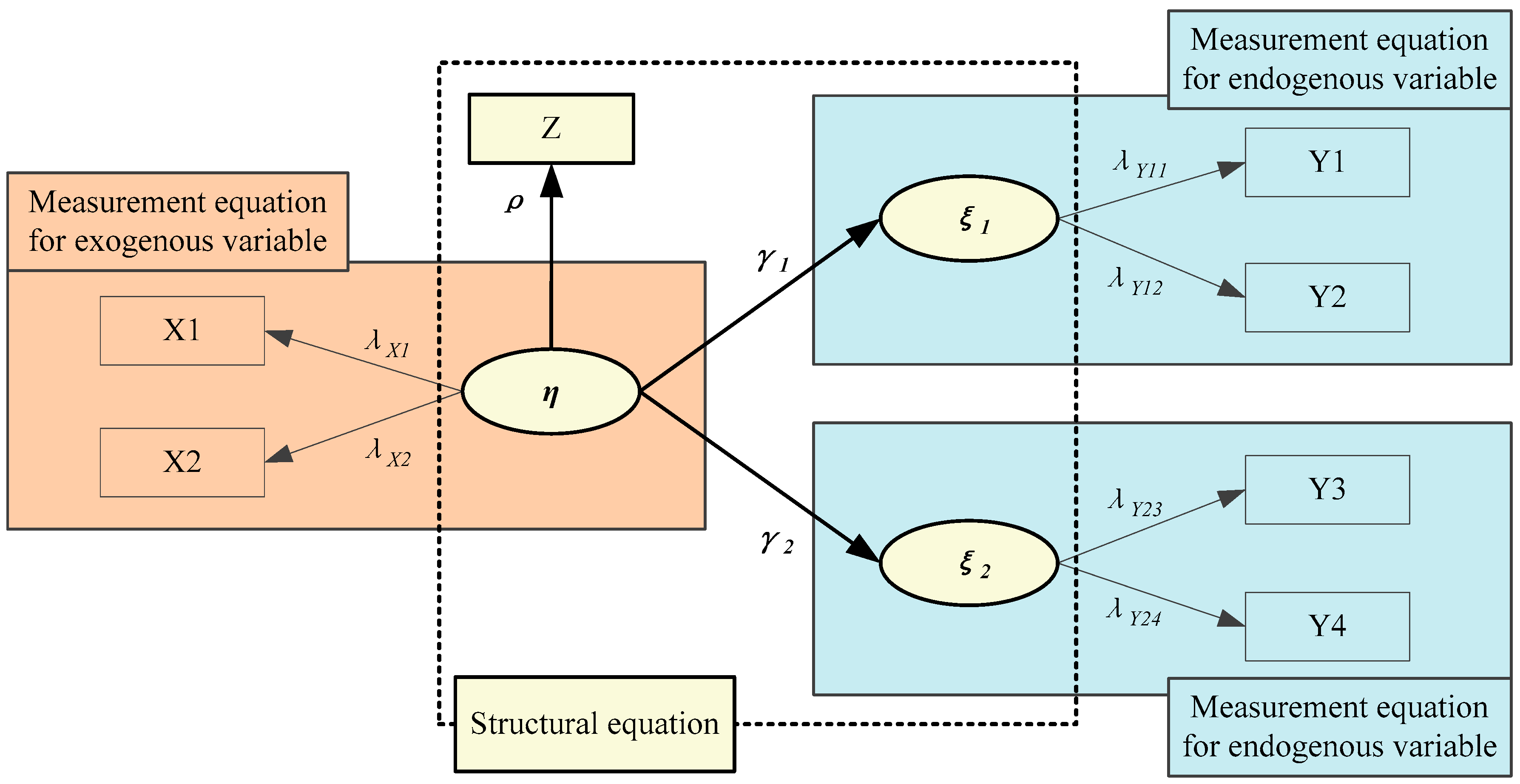

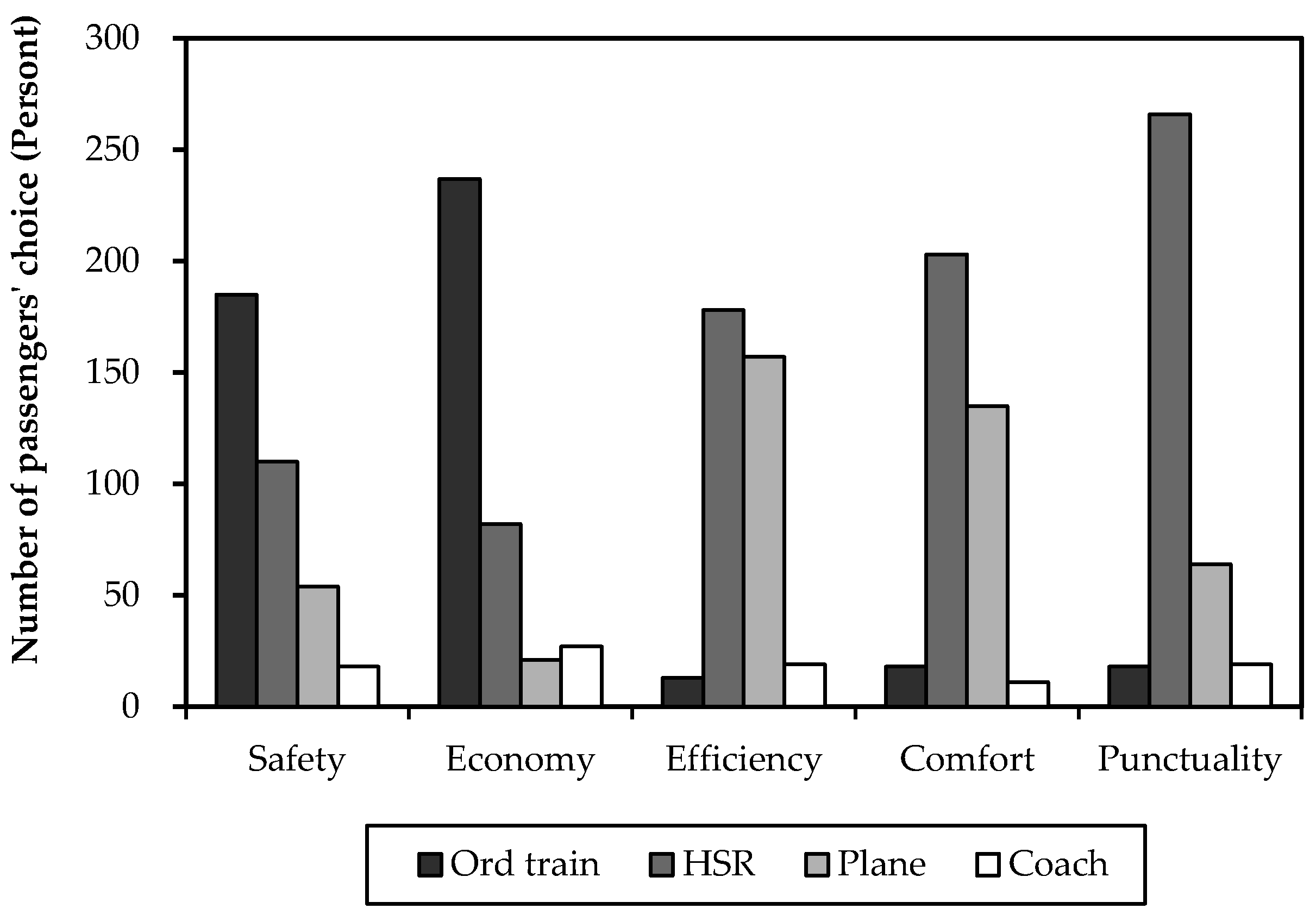
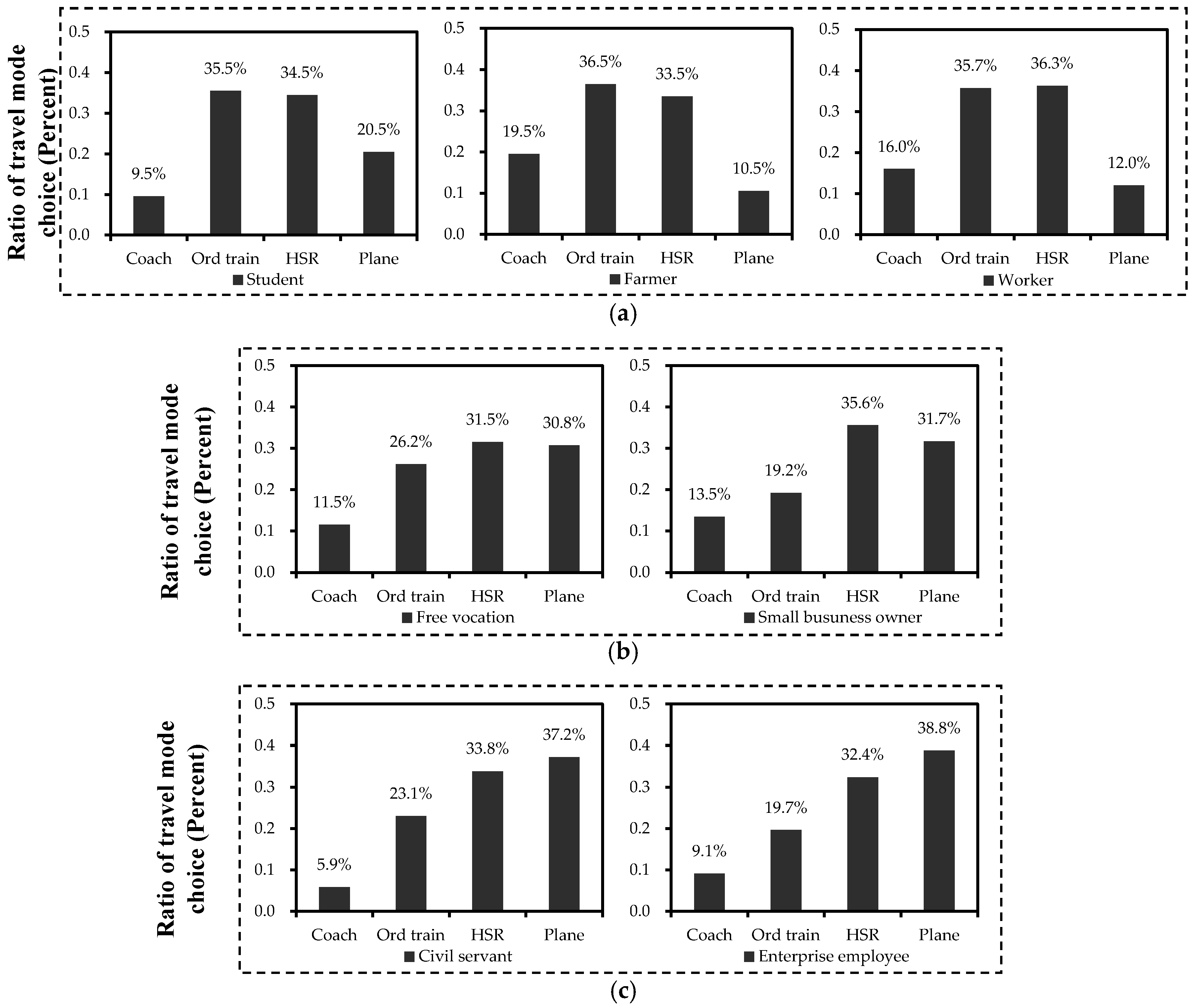
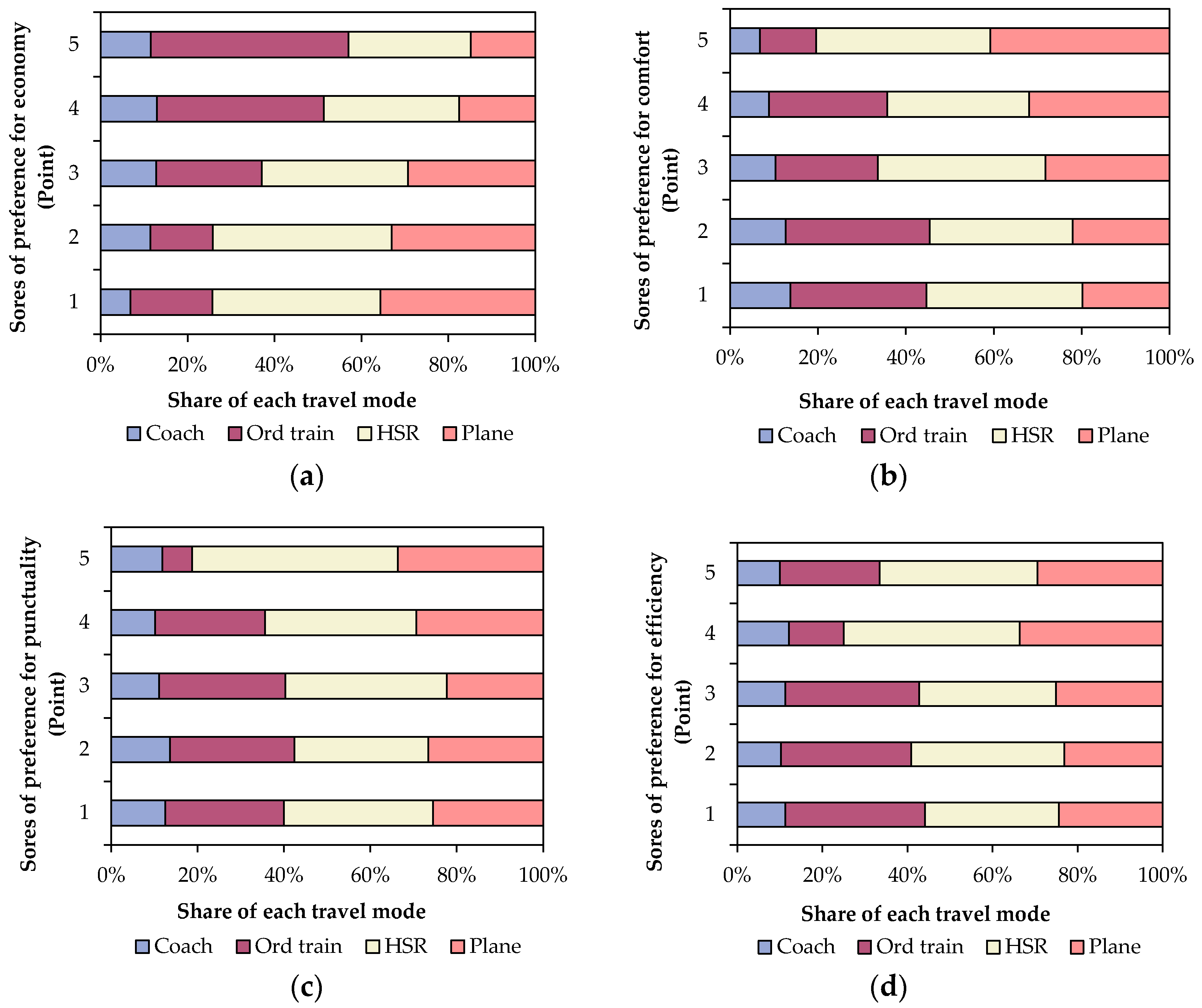
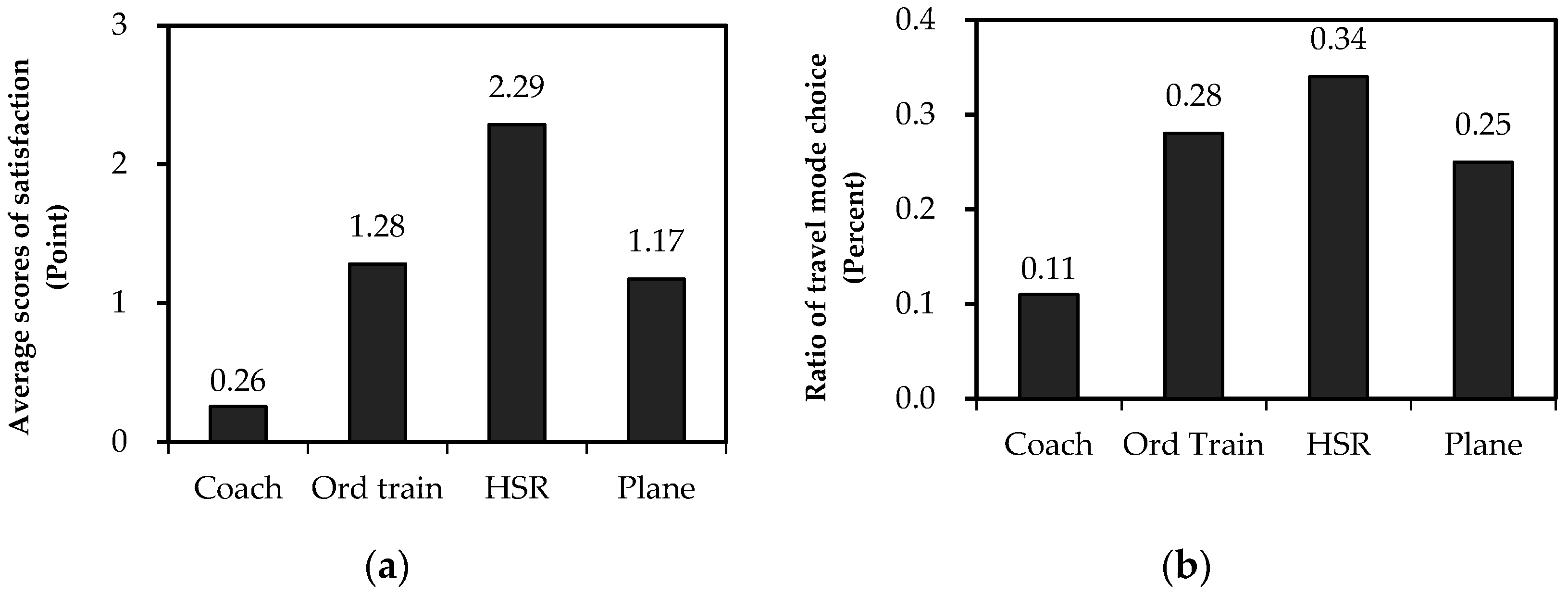

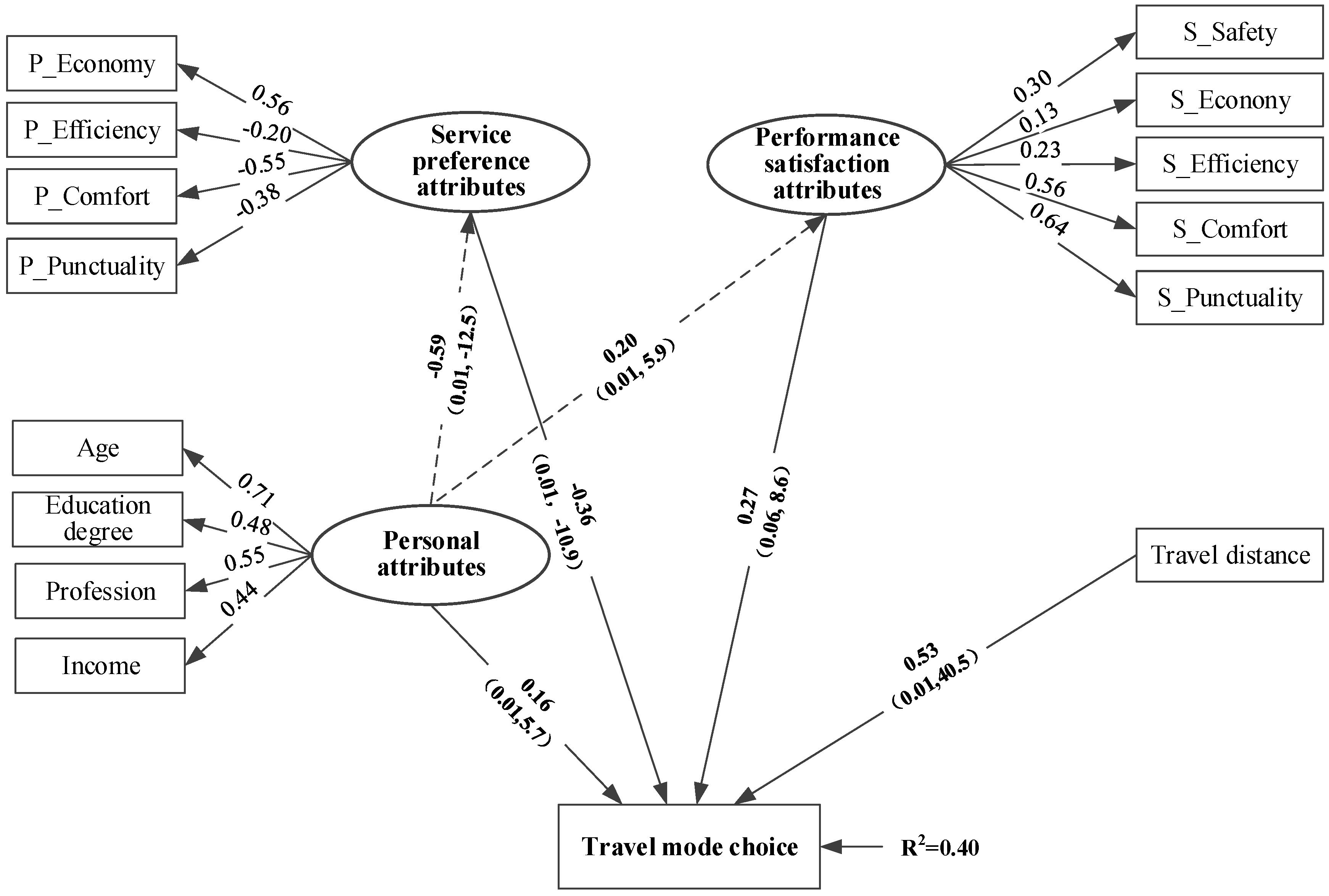
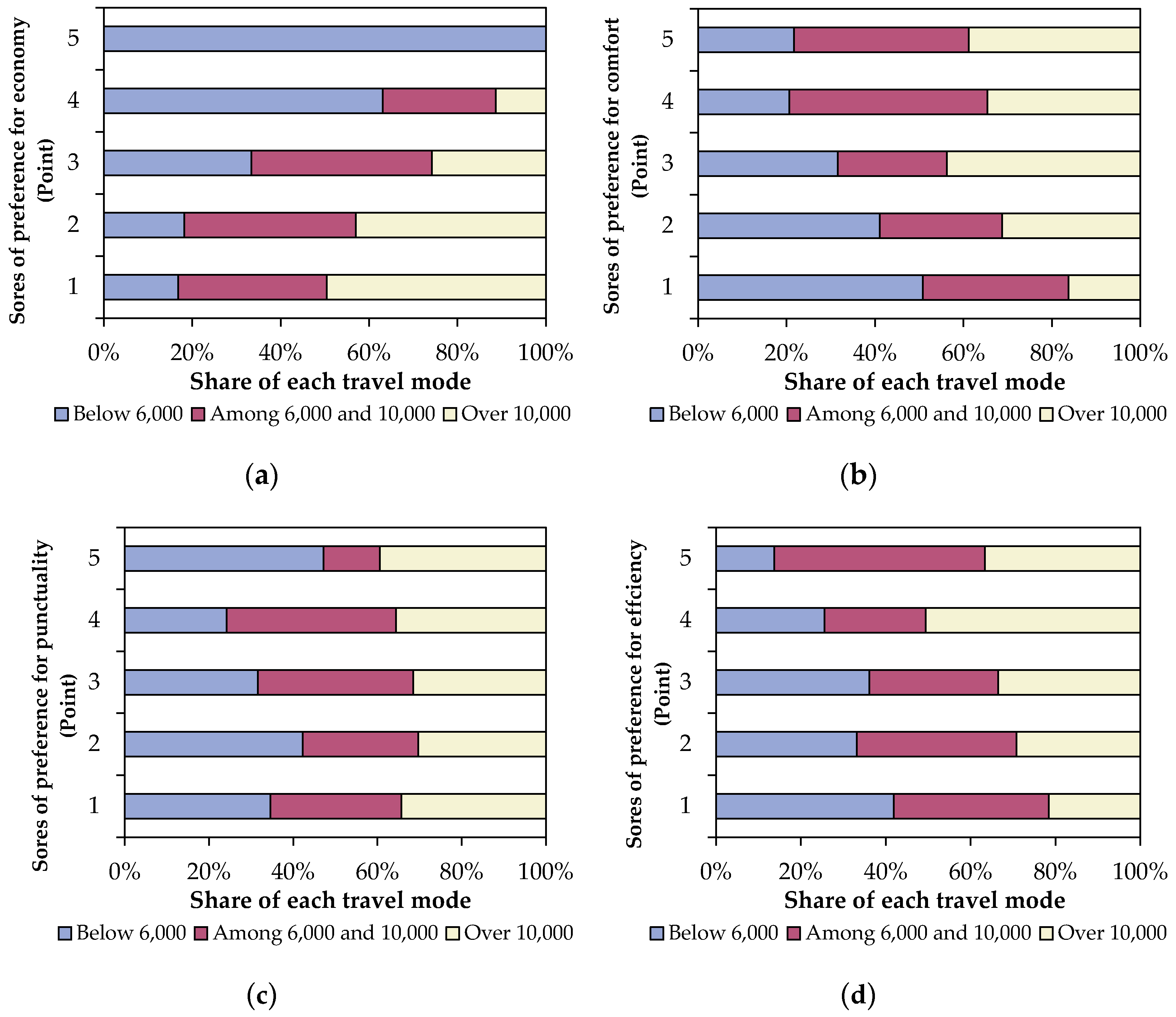
| Variables | Description/Levels | Frequency | Percentage (%) |
|---|---|---|---|
| Gender | Male | 236 | 64.31% |
| Female | 131 | 35.69% | |
| Age | Below 20 | 11 | 3% |
| 20–29 | 176 | 48% | |
| 30–39 | 74 | 20.2 | |
| 40–49 | 70 | 19.1 | |
| Above 50 | 36 | 9.8 | |
| Education level | Low-education | 188 | 51.20% |
| Middle-education | 154 | 42.00% | |
| High-education | 25 | 6.80% | |
| Vocation | Student | 108 | 29.4% |
| Farmer | 20 | 5.4% | |
| Civil servant | 38 | 10.4% | |
| Small business owner | 52 | 14.2% | |
| Worker | 36 | 9.8% | |
| Free vocation | 41 | 11.2% | |
| Enterprise employees | 56 | 15.3% | |
| Others | 16 | 4.4% | |
| Income | Low-income | 293 | 80.00% |
| Middle-income | 44 | 12.00% | |
| High-income | 30 | 8.00% |
| Service Preference Attributes | Most Important | Second Important | Third Important | Forth Important | Least Important | Total |
|---|---|---|---|---|---|---|
| Safety | 285 | 35 | 25 | 19 | 3 | 367 |
| Price | 27 | 125 | 72 | 65 | 66 | 367 |
| Comfort | 25 | 76 | 62 | 104 | 86 | 367 |
| Punctuality | 19 | 80 | 111 | 70 | 105 | 367 |
| Efficiency | 11 | 81 | 75 | 109 | 99 | 367 |
| Variables | Sum of Squares | df | Mean Square | F | Sig | |
|---|---|---|---|---|---|---|
| Passengers’ socio-demographic characteristics | Gender | 0.5 | 1 | 0.5 | 0.5 | 0.48 |
| Education level | 65.5 | 2 | 32.7 | 35.7 | 0.00 * | |
| Vocation | 130.3 | 7 | 18.6 | 20.7 | 0.00 * | |
| Income | 125.7 | 7 | 18.0 | 19.9 | 0.00 * | |
| Service preference attributes | Preference for safety | 12.0 | 4 | 3.0 | 3.2 | 0.12 |
| Preference for price | 196.8 | 4 | 49.2 | 55.9 | 0.00 * | |
| Preference for efficiency | 107.5 | 4 | 26.9 | 29.7 | 0.00 * | |
| Preference for comfort | 146.3 | 4 | 36.6 | 40.9 | 0.00 * | |
| Preference for punctuality | 83.8 | 4 | 21.0 | 23.0 | 0.00 * | |
| Performance satisfaction | Satisfaction of safety | 90.6 | 4 | 22.6 | 24.9 | 0.00 * |
| Satisfaction for price | 57.9 | 3 | 19.3 | 21.0 | 0.00 * | |
| Satisfaction for efficiency | 23.4 | 3 | 7.8 | 8.4 | 0.00 * | |
| Satisfaction for comfort | 28.8 | 3 | 9.6 | 10.4 | 0.00 * | |
| Satisfaction for punctuality | 44.2 | 3 | 14.7 | 16.0 | 0.00 * | |
| Trip attributes | Departure time | 2.1 | 1 | 2.1 | 2.3 | 0.13 |
| Travel distance | 10,007.0 | 4 | 251.8 | 381.6 | 0.00 * | |
| Independent Variables | Coach | Ordinary Train | HSR | Plane | ||||
|---|---|---|---|---|---|---|---|---|
| N | % | N | % | N | % | N | % | |
| Age | ||||||||
| Below 20 | 12 | 10.9 | 31 | 28.2 | 50 | 45.5 | 17 | 15.5 |
| 20–29 | 201 | 11.4 | 546 | 31.0 | 566 | 32.2 | 447 | 25.4 |
| 30–39 | 81 | 10.9 | 159 | 21.5 | 271 | 36.6 | 229 | 30.9 |
| 40–49 | 85 | 12.1 | 176 | 25.1 | 237 | 33.9 | 202 | 28.9 |
| Above 50 | 27 | 7.5 | 122 | 33.9 | 137 | 38.1 | 74 | 20.6 |
| Education | ||||||||
| Low-education | 250 | 13.3 | 563 | 29.9 | 655 | 34.8 | 412 | 21.9 |
| Middle-education | 136 | 8.8 | 436 | 28.3 | 519 | 33.7 | 449 | 29.2 |
| High-education | 20 | 8.0 | 35 | 14.0 | 87 | 34.8 | 108 | 43.2 |
| Vocation | ||||||||
| Student | 104 | 9.5 | 387 | 35.5 | 376 | 34.5 | 223 | 20.5 |
| Farmer | 39 | 19.5 | 73 | 36.5 | 67 | 33.5 | 21 | 10.5 |
| Civil servant | 23 | 5.9 | 90 | 23.1 | 132 | 33.8 | 145 | 37.2 |
| Small business owner | 70 | 13.5 | 100 | 19.2 | 185 | 35.6 | 165 | 31.7 |
| Worker | 56 | 16 | 125 | 35.7 | 127 | 36.3 | 42 | 12.0 |
| Free vocation | 45 | 11.5 | 102 | 26.2 | 123 | 31.5 | 120 | 30.8 |
| Enterprise employees | 53 | 9.1 | 114 | 19.7 | 188 | 32.4 | 225 | 38.8 |
| Others | 16 | 10.7 | 43 | 28.7 | 63 | 42 | 28 | 18.7 |
| Income | ||||||||
| Low-income | 302 | 11.3 | 879 | 32.8 | 923 | 34.4 | 576 | 21.5 |
| Middle-income | 68 | 11.5 | 121 | 20.5 | 195 | 33.1 | 206 | 34.9 |
| High-income | 36 | 9.0 | 34 | 8.5 | 143 | 35.8 | 187 | 46.8 |
| Total | 406 | 11.1 | 1034 | 28.2 | 1261 | 34.4 | 969 | 26.4 |
| Travel Mode | Competitive Travel Distance Scope | Performance Features | Target Passenger Groups | Relevant Suggestions |
|---|---|---|---|---|
| Coach | <500 km. | low satisfaction degree of service performances. | lack of competitiveness among all groups. | (1) vigorously improving service quality; (2) enhancing the highway construction between cities to provide proper environment for haul business in relatively short distance. |
| Ordinary train | 500–1000 km. | low travel expense; high satisfaction degree of safety performance; low satisfaction degree of the performances on efficiency, comfort and punctuality. | low-income; student, farmer and worker. | (1) providing diversified service; (2) broadening the competitive distance scope to longer distance. |
| HSR | highly competitive over each distance scope, especially within 500–1000 km. | high travel expense; satisfied performances on safety, efficiency, comfort and punctuality. | highly competitive among almost all groups. | (1) taking economic incentive strategies, such as ticket discount and bonus points; (2) improving the construction of branch lines in the middle-long distance. |
| Plane | highly competitive in relatively long distance, especially over 2000 km. | high travel expense; low satisfaction degree of punctuality performance; satisfied performances on comfort and efficiency. | high-income; civil servant, enterprise employee. | (1) improving punctuality performance to ensure reliability; (2) properly taking economic incentive strategies. |
| Variables | Coding of Input Value | ||
|---|---|---|---|
| Latent Variable | Observed Variable | Description | |
| Personal attributes | Age | Passenger’s age group. | 1→ Below 20 |
| 2→ 20–29 | |||
| 3→ 30–39 | |||
| 4→ 40–49 | |||
| 5→ Above 50 | |||
| Education | Passenger’s education level. | 1→ high school or under | |
| 2→ bachelor degree | |||
| 3→ master degree or above | |||
| Vocation | Passenger’s vocation classification. | 1→ student | |
| 2→ farmer | |||
| 3→ civil servant | |||
| 4→ small business owner | |||
| 5→ worker | |||
| 6→ free vocation | |||
| 7→ enterprise employees | |||
| 8→ others | |||
| Income | Passenger’s income level. | 1→ <6000 RMB | |
| 2→ 6000–10,000 RMB | |||
| 3→ >10,000 RMB | |||
| Service preference attributes | P_Economy/ | Passenger’s ranking on preference about safety, economy, efficiency, comfort and punctuality for long distance travel. | 1→ the least important |
| P_Efficiency/ | 2→ the forth important | ||
| P_Comfort/ | 3→ the third important | ||
| P_Punctuality | 4→ the second important | ||
| 5→ the most important | |||
| Performance satisfaction attributes | S_Safe/ | Passenger’s satisfaction to the most competitive travel mode in safety, economy, efficiency, comfort and punctuality respectively. | 1→ coach |
| S_Economy/ | 2→ ordinary train | ||
| S_Efficiency/ | 3→ HSR | ||
| S_Comfort/ | 4→ plane | ||
| S_Punctuality | |||
| / | Distance | The assumptive travel distance of long distance travel. | 1→ <500 |
| 2→ 500–1000 | |||
| 3→ 1000–1500 | |||
| 4→ 1500–2000 | |||
| 5→ >2000 | |||
| / | Travel mode choice | Passenger’s mode choice under a certain assumptive travel time and travel distance. | 1→ coach |
| 2→ ordinary train | |||
| 3→ HSR | |||
| 4→ plane | |||
| Equations | Observed Variables | Latent Variables | Estimate | S.E. | t-Value | p |
| Measurement equation for exogenously latent variable (personal attributes) | Income | Personal attributes | 1 | *** | ||
| Vocation | Personal attributes | 4.776 | 0.26 | 18.364 | *** | |
| Education level | Personal attributes | −0.878 | 0.051 | −17.273 | *** | |
| Age | Personal attributes | 2.814 | 0.145 | 19.339 | *** | |
| Measurement equation for exogenously latent variable (service preference and performance satisfaction) | P_Punctuality | Service preference | −0.832 | 0.078 | −10.629 | *** |
| P_Comfort | Service preference | −0.974 | 0.105 | −9.291 | *** | |
| P_Efficiency | Service preference | −0.272 | 0.033 | −8.200 | *** | |
| P_Economy | Service preference | 1 | ||||
| S_Punctuality | Satisfaction | 1 | ||||
| S_Comfort | Satisfaction | 0.925 | 0.125 | 7.409 | *** | |
| S_Efficiency | Satisfaction | 0.425 | 0.063 | 6.692 | *** | |
| S_Economy | Satisfaction | 0.208 | 0.037 | 5.614 | *** | |
| S_Safety | Satisfaction | 0.567 | 0.082 | 6.953 | *** | |
| Equations | Endogenously Latent Variables | Exogenously Latent Variables | Estimate | S.E. | t-Value | p |
| Structural equation for travel mode choice mechanism in long-distance | Service preference | Personal attributes | −1.13 | 0.09 | −12.544 | *** |
| Satisfaction | Personal attributes | 0.059 | 0.01 | 5.899 | *** | |
| Mode choice | Service demand | −0.669 | 0.061 | −10.947 | *** | |
| Mode choice | Satisfaction | 0.532 | 0.062 | 8.583 | *** | |
| Mode choice | Travel distance | 0.362 | 0.009 | 40.493 | *** | |
| Mode choice | Departure time | 0.042 | 0.025 | 1.67 | 0.095 | |
| Mode choice | Personal attributes | 0.557 | 0.098 | 5.697 | *** |
| Latent Variables | Observed Variables | Direct Effects | Indirect Effects | Total Effects |
|---|---|---|---|---|
| Personal Attributes | 0.16 | −0.59 × −0.36 + 0.20 × 0.27 = 0.27 | 0.43 | |
| Age | 0.11 | 0.71 × 0.27 = 0.19 | 0.30 | |
| Education level | 0.08 | 0.48 × 0.27 = 0.13 | 0.20 | |
| Vocation | 0.09 | 0.55 × 0.27 = 0.15 | 0.23 | |
| Income | 0.07 | 0.44 × 0.27 = 0.12 | 0.19 | |
| Fix Index | SEM Models | Criteria of Acceptable Fit |
|---|---|---|
| Chi-square | 86.785 | Smaller values |
| df | 75 | |
| p-value | 0.016 *** | >0.05 |
| GFI | 0.997 | >0.9 |
| AGFI | 0.994 | >0.9 |
| CFI | 0.998 | >0.9 |
| NFI | 0.988 | >0.9 |
| RMSEA | 0.007 | <0.05 |
© 2017 by the authors. Licensee MDPI, Basel, Switzerland. This article is an open access article distributed under the terms and conditions of the Creative Commons Attribution (CC BY) license (http://creativecommons.org/licenses/by/4.0/).
Share and Cite
Wang, Y.; Yan, X.; Zhou, Y.; Xue, Q. Influencing Mechanism of Potential Factors on Passengers’ Long-Distance Travel Mode Choices Based on Structural Equation Modeling. Sustainability 2017, 9, 1943. https://doi.org/10.3390/su9111943
Wang Y, Yan X, Zhou Y, Xue Q. Influencing Mechanism of Potential Factors on Passengers’ Long-Distance Travel Mode Choices Based on Structural Equation Modeling. Sustainability. 2017; 9(11):1943. https://doi.org/10.3390/su9111943
Chicago/Turabian StyleWang, Yun, Xuedong Yan, Yu Zhou, and Qingwan Xue. 2017. "Influencing Mechanism of Potential Factors on Passengers’ Long-Distance Travel Mode Choices Based on Structural Equation Modeling" Sustainability 9, no. 11: 1943. https://doi.org/10.3390/su9111943





